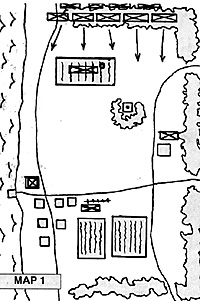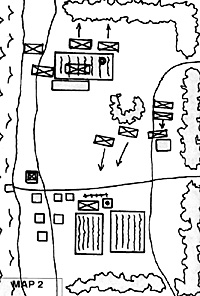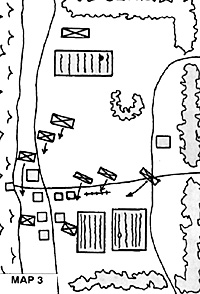 One of the more interesting theaters of action in the Great War was German
East Africa. Though considered a sideshow at the time, the German colony was the
site of what may arguably be the greatest guerilla campaign ever waged. German
Colonel Paul von Lettow-Vorbeck waged a brilliant war of attrition against the British,
a war made all the more remarkable because he was totally cut off from Germany.
He led a force of German colonial troops (Schutzetruppen), German civilian
volunteers and native askaris that never numbered more than ten thousand men.
By the time he was finally convinced that the war was over, his force was down to
about 2,000 men, and over 350,000 British and Commonwealth troops were in the
field attempting to run him to earth.
One of the more interesting theaters of action in the Great War was German
East Africa. Though considered a sideshow at the time, the German colony was the
site of what may arguably be the greatest guerilla campaign ever waged. German
Colonel Paul von Lettow-Vorbeck waged a brilliant war of attrition against the British,
a war made all the more remarkable because he was totally cut off from Germany.
He led a force of German colonial troops (Schutzetruppen), German civilian
volunteers and native askaris that never numbered more than ten thousand men.
By the time he was finally convinced that the war was over, his force was down to
about 2,000 men, and over 350,000 British and Commonwealth troops were in the
field attempting to run him to earth.
This fruitless tying up of troops desperately needed on the Western Front was Lettow-Vorbeck's contribution to the Fatherland; he saw early that he would be unable to help his country in any other way. HE was brilliant in the accomplishment of his self-imposed task.Tanga was a port town in German East Africa. Although fairly useless as a port to the Germans, the British could certainly make use of it. Also, recent successes by Lettow-Vorbeck required some sort of response by the British.
Accordingly, Tanga was designated as one of the targets of a two-pronged invasion of German East Africa. The task of conquering Tanga fell to a mixed bag of (mostly) Commonwealth troops; most were Indians of the,37th Bangalore Brigade and the Imperial Service Brigade. They were at best second-line troops, whose effectiveness was further impaired by the fact that they were landed directly into combat after an excruciating crossing from India that took several weeks.
The 8,000 men were under the command of (temporary) Major General Arthur Aitken, an officer of long service in the Indian Army, whose orders were "...to bring the whole of German East Africa under British authority." The only British battalion of the force was the 2nd Battalion, Loyal North Lancashire Regiment. The Official History later referred to the troops as of "...doubtful fighting quality."
The Germans had considerably fewer men available to defend the town. Aside from any problem that Lettow-Vorbeck had with the military aspects of his job, the civilian governor of German East Africa, Governor Schnee, had sent orders forbidding any active defense of the town. (Lettow-Vorbeck was to put up with Schnee's divisiveness and obstructionism for the entire war. Although Schnee was the nominal commander in the area, there was never any question about who was in charge.) Lettow-Vorbeck was outnumbered 8-1; much of his usable strength came up during the fight, and was put into the line as it arrived over the antiquated railway. Ever aggressive, Lettow-Vorbeck was anxious for reinforcements so he could counterattack.
 Tanga was a small town, a few buildings with a small dock, surrounded by
rubber and sisal plantations, mangrove swamps and jungle. Aitken's plan was to
land his force south of the town, dress his lines and sweep the Germans out. His
non-use of any intelligence available to him was only exceeded by the complete
lack of any operational security. Lettow-Vorbeck knew of the British plans almost
as soon as the British. The troops went ashore on 3 November 1914; the battle went
wrong from the start.
Tanga was a small town, a few buildings with a small dock, surrounded by
rubber and sisal plantations, mangrove swamps and jungle. Aitken's plan was to
land his force south of the town, dress his lines and sweep the Germans out. His
non-use of any intelligence available to him was only exceeded by the complete
lack of any operational security. Lettow-Vorbeck knew of the British plans almost
as soon as the British. The troops went ashore on 3 November 1914; the battle went
wrong from the start.
Aitken remained aboard the transports and was, after action had been joined, reduced to judging the progress of his troops from the sound of the firing. The Germans made masterful use of cover and concealment and ate up the British units with heavy rifle and machinegun fire. Fighting was heavy in places, and the German askaris were forced to give ground in places, but mostly it was a scene of panic and rout on the part of the sea-sick and fearful Commonwealth troops.
There were numerous instances of panicky Indian troops firing into friendly units. Both sides hand to contend with not only heavy machinegun fire, but the swarms of African bees that were disturbed by the fighting; several companies on both sides were routed by the bees and the Germans were accused in the British press of deliberately planting 'beehive mines'. The British got some artillery support in the form of the HMS Fox's 6 inch guns; unfortunately there was no one ashore to direct the fire and the rounds were fired pretty much at random into the town.
The German hospital was hit and the Germans protested this barbarous act quite vehemently. The British apologized, of course. The operation was a shambles pretty much from start to finish and the British withdrew, leaving behind a considerable store of supplies, weapons and ammunition for Lettow-Vorbeck to re-equip his troops.
For the game, the terrain was set up as shown in map #1; this terrain is entirely fictitious since I had no maps of Tanga available. The forces were arrayed with a 31 advantage to the British (Although their actual strength was more like 8-1, I cut it down because I didn't expect the game Brit to be quite as inept as his historical counterpart.) Their forces entered the south edge of the board on turn 1. German forces were in place on the board as shown, with reinforcements available on later turns; the reinforcements' turn of arrival was determined by roll of a D6. All German reinforcements appeared at the north board edge. The Germans had the support of one 4 gun battery of light field pieces. The British had the HIVIS Fox, whose 6-inch guns were controlled by the referee. (20 random firing points were distributed over the board. From turns 3-9, the Fox fired a salvo on one of these points; the exact location was determined by throw of D20). There was also one major bee-hive hidden on the board; the unit that stirred up the bees would be required to take a morale check, with large detriments.
 The play of the game was pretty straight-forward. The British advanced on a
broad frontage, while the Germans attempted to slow the advance with long range
rifle and machine-gun fire. For some reason, the German commander forgot about
his artillery support and it was never used. The lone German machine gun was
swiftly overrun by the British left wing commander, who skillfully kept up a steady
fire by leapfrogging his units forward. On the right wing, the British advance was
first held up by a company of Askaris, whose fire was very effective as the range
shortened. It actually came to crossed bayonets and the Askaris, outnumbered 4-1,
put the British to flight at the cost of being wiped out. The British right wing also
found the bees, and about half their force routed away.
The play of the game was pretty straight-forward. The British advanced on a
broad frontage, while the Germans attempted to slow the advance with long range
rifle and machine-gun fire. For some reason, the German commander forgot about
his artillery support and it was never used. The lone German machine gun was
swiftly overrun by the British left wing commander, who skillfully kept up a steady
fire by leapfrogging his units forward. On the right wing, the British advance was
first held up by a company of Askaris, whose fire was very effective as the range
shortened. It actually came to crossed bayonets and the Askaris, outnumbered 4-1,
put the British to flight at the cost of being wiped out. The British right wing also
found the bees, and about half their force routed away.
Once this mess was straightened out, the British luck held firm and the Fox began dropping a rolling barrage on the heads of the advancing British troops. This served to further delay and disrupt the advance. In fact, the advance on the left was stopped cold, not by the Schutztruppe, but by a well-placed Fox salvo which devastated a company bunched up on the crossroad. The Germans were never touched by the British artillery fire; however, weight of numbers told and the British were not kept out of town in spite of their fearful casualties.
After ten turns, the German commander conceded that his forces were not strong enough to regain the town and the game was called.
The post mortern focussed on the German commander's deployment of his troops. He spread himself far too thin against a numerically superior enemy; as a result, he was defeated in detail in spite of inflicting far worse damage than he received. The forward deployment of one of his machine guns served no useful purpose, and the Askari company in the cultivated field was unsupported and stayed too long before falling back. As a result they were wiped out, but not before giving good account of themselves. The hero of the battle for the Germans was determined to be the gunnery officer on HMS Fox.
As luck would have it, five of the six turns of fire landed on top of British units. We later determined that more casualties were caused by this friendly fire than by the Germans (total losses were 49% for the British and 74% for the Germans). Had the Germans deployed in mutually supporting positions and made use of their artillery, the British attack would probably have been defeated.
As it was, it was a near run thing, in spite of the heavy German casualties. The order of battle is as follows:
GERMANS
One company of Schutztruppen 8 figures
Two companies of Askaris - 9 figures each
One Friekorps company - 5 figures
Two HMG sections 4 figures/2 guns
One light battery - 4 figures - off board only
Reinforcements - one 6 figure Schutztruppe company enters on turn
determined by die roll.
BRITISH
Nine cpys of Commonwealth Troops 9 figures each
Two companies of British regulars - 9 figures each
Two batteries of heavy guns firing at random from the HMS Fox
British forces enter on turn one; the Fox fires each turn on turns 3-9.
Over There is written by Nick Yankosky and is available from Rivertown Pubs., Rivertown Hobbies, P.O. Box 558023, Cincinnati, OH, 45255; $7
Over There Warfare 1900-1929 Miniature Rules
Back to Table of Contents -- Courier #58
To Courier List of Issues
To MagWeb Master Magazine List
© Copyright 1992 by The Courier Publishing Company.
This article appears in MagWeb (Magazine Web) on the Internet World Wide Web.
Other articles from military history and related magazines are available at http://www.magweb.com